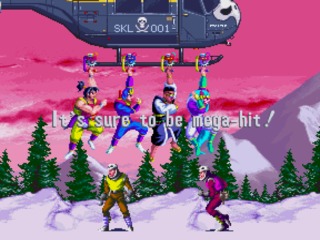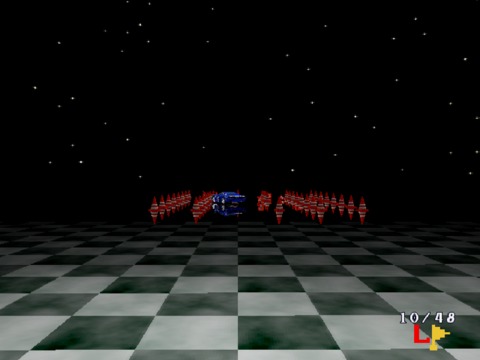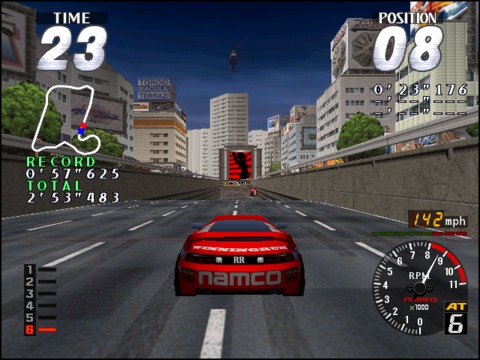Ridge Ranker: #4
By PistonHyundai 0 Comments
[This is the seventh entry in a countdown of the best Ridge Racer games. I recommend you read the introduction before reading this; it includes a brief history of the series and links for each entry.]
Rave Racer - Arcade, 1995
Arcade, Come Home
The arcade exclusive is a class of game that becomes more depressing as time goes on. As both arcades and the machines within them continue to die out and decay, the lifelines of countless games get shorter and shorter. While many arcade experiences end up receiving ports to home consoles or even given a second chance thanks to an interested third party company (God bless you, HAMSTER Corporation), far too many games are rendered victims to defunct or uncaring parent companies, idiosyncratic hardware that proves difficult to translate to the home, or other unfortunate circumstances. It's not unlikely that many peoples' potential favorite games could be sitting in some warehouse or dump somewhere, left to be undiscovered by would-be evangelists. You may think I'm being hyperbolic, but some of the most interesting games to ever grace arcades never left them:

- Midway's The Grid married the burgeoning arena shooter genre with the Running Man sensibilities of Smash TV, and while you can see the influence of many different games in it, it's also quite ahead of its time. Playable characters have unique abilities similar to the hero shooters of today, and it may be one of the earliest competitive shooters to have a persistent upgrade/leveling system. Unfortunately, the unique architecture of the Midway Zeus 2 hardware it ran on meant that the game never saw a port.
- Capcom's Strider is regarded as a classic, but director Kouichi Yotsui's spiritual successor Osman often goes unnoticed. Described by Yotsui himself as a parody of sorts, Osman is deliberately outlandish and sports an incomprehensible storyline, but more importantly has wonderful melee-based gameplay and a striking Persian cyberpunk aesthetic. It's right up there with the source material, but its commercial failure doomed it to obscurity.
- Namco's The Outfoxies is the grandfather of Super Smash Bros., featuring arena fighting action that is shockingly similar to Nintendo's hit series (appropriate, considering Namco would go on to work on Smash games themselves). It has huge, dynamic levels full of hazards and weapons, and a spy movie theme that's equal parts slick and absurd. It's a kickass game in its own right, but never received a port. How didn't a Namco suit see what a potential multiplayer classic this could've become on the PlayStation?
- Released at a time where Konami just couldn't stop dropping incredible games left and right, Mystic Warriors was lost in the shuffle. Taking place in a futuristic New York City by way of the Samurai, Mystic Warriors is one of the best run-and-guns of the 90s. There's great visuals and gameplay, and even a surprisingly decent narrative that easily has the greatest voice acting in a video game of its time (which isn't saying a lot, but still). It's hard to see why this was never included in a compilation somewhere. Oh, and did I mention that it's essentially a sequel to Sunset Riders?
- Look at Survival Arts. Just look at it. Jesus Christ, look at this damn thing.
These games deserve better than to just waste away in a scrap heap somewhere, and while there are companies out there like Digital Eclipse and M2 keeping some of these games alive, many still fall through the cracks, and that's where efforts like the Video Game History Foundation and homebrew emulators come in. The only way the vast majority of people can actually play most of these games is through programs like MAME (Multiple Arcade Machine Emulator), a project focused on preserving the overwhelming library of thousands of arcade games. It isn't perfect (and a perpetual work-in-progress), but it's the best we have for far too many games.
This brings us to Rave Racer.
Rave Review

Rave Racer marks the end of Ridge Racer's time as an arcade-focused franchise, and it's hard to picture a higher note for it to go out on. As the first honest-to-god sequel in the Ridge Racer series, it feels much more confident in its aesthetic (the influence of the series' iconic music bleeding into both its visuals and the game's name), and is even a touch experimental, being host to mechanics and concepts that the series would take over a decade to revisit, if at all. Throw in two new racetracks and both versions of the original Ridge Racer course, and you have what is easily the best arcade game in the series.
Driving in Rave Racer feels a lot like the prior arcade games, but some important distinctions are made here. Handling is a little more realistic in and out of drifts (although some issues pop up in emulation, but more on that later), and sharp turns feel more like an actual car skidding than the bizarrely smooth, on-rails nature displayed in the prior two games. It's still Ridge Racer at the end of the day, but it's more reminiscent of, you know, driving a car. What isn't realistic is the "trampling" mechanic exclusive to this game: if you manage to land on a rival vehicle after taking a jump, you get a sizable speed boost. It's impractical, but it really helps out if you can pull it off, and if you're really good you can exploit a glitch and straight up break the game with it. Drafting makes its debut here as well (arcade fliers for Ridge Racer 2 make note of it being present in that game, but I honestly couldn't tell), and even though it's much easier to pull off compared to the trample, the boost in speed is negligible. In fact, it seems to be more of an acceleration boost than anything. Regardless, driving feels excellent and these additions encourage you to approach races more aggressively compared to many other games in the series (at least until Ridge Racer 7 introduces a more substantial form of drafting with its slipstream mechanic), making it stand out from its brethren.
Two new circuits, simply titled "City" and "Mountain," join the original Ridge Racer tracks, and they're among some of my favorites in the series. Both tracks give their respective themes room to breathe compared to the original RR tracks, which felt more like a video game-y tour of loosely-connected visual showpieces. City takes you on a lengthy highway trip through a metropolis and its adjacent industrial zone, peppering in big jumps and some quick corners along the way. Mountain, on the other hand, uses a rural mountain range to put on a veritable technical driving clinic. You'll be clearing multiple bends with a single drift, using split-second drifts to clear tight chicanes, and lining up jumps to avoid crashing into the sidewall just before the finish line. It's one of the trickiest course designs this side of Rage Racer, but the car physics make it an appealing challenge. These tracks would find their way into the PSP Ridge Racer almost a decade later, but Mountain ends up having a lot of its intricacies stripped away in the process. The starting line is moved from a bespoke tunnel to on the track itself, which would normally be frivolous, but results in a secret boost start going missing in the PSP iteration. More importantly, the track's defining hazard, a cliff that you can actually fall down, landing in a tunnel detour that eventually rejoins the main track (the only instance of this in the entire series), is removed on the PSP, meaning the full version of the Mountain circuit remains exclusive to Rave Racer.
Visually, the game is one of the most impressive of its era, second to only SEGA's games on their flagship Model 2 hardware. Textures have improved significantly in the time since Ridge Racer, giving way to cars with actual game logos plastered on them (instead of just having plain text that says "BARADUKE" or "XEVIOUS" on a car's exterior) and animated signs and billboards that pop out at the player. The City course in particular is a visual treat, with oodles of flashing neon signs giving a perfect home for the energetic soundtrack. It's so nice looking that you begin to understand why there was never a port as you play it: consoles just couldn't have handled it at the time.

All four members of the SamplingMasters unit return for Rave Racer, and you can just tell that they didn't want to appear complacent and supply the expected bevy of electronic music for this game. Don't get me wrong, the soundtrack lives up to the name Rave Racer (Wrong Love, Kamikaze, the intoxicating pep of Euphoria...), but this is one of the most diverse collections of songs across all of Ridge Racer, employing a wide array of genres and styles while maintaining its penchant for danceable racing beats. Every SamplingMasters member uses this game as an opportunity to spread their wings: MEGA and AYA provide maybe the most "safe" set of tracks, but the former throws in Yororeri Hey, a chipper tune that plays around with a yodeling sample for most of its runtime, while the latter's Heart of Hearts exudes a dancehall flavor (including a vocal sample that seemingly talks about passing a blunt). J99 only has two tracks (and one of them is a post-race tune that only shows up in-game for a few seconds) but he channels SEGA AM2 racers like OutRun with Blue Topaz, a rare venture into a more South American sound, that still throws in plenty of samples. sanodg, however, has a god damn field day here. There's the flowery drum 'n' bass majesty of EXH* Notes (stick with this one for the incredible breakdown), the self-explanatory Jazz Mission, the most divergent Rare Hero entry yet in the house-influenced Pole Position tribute Rare Hero 3 (Pacific Mix), and Teknopera, which does exactly what you think it would. I can't decide if Rave Racer's soundtrack is my favorite in the series, but its sheer variety keeps a lot of its tracks fresh in my mind. If you had to pick just a single Ridge Racer soundtrack to listen to from this list, make it this one. It's wild.
Now, the unfortunate reality is that most of us aren't going to be able to play the game the way it's intended, which leaves two options for emulating. MAME supports Rave Racer (along with the Ridge Racer 1 & 2), but has trouble running it at the locked 60FPS of the genuine article, and the audio will skip over itself constantly, which isn't exactly ideal. On the other hand, the viva nonno emulator is capable of running the game at full speed without sound issues, but was last updated in 2003 (on January 1st, even) and is a nightmare to get going properly. Crashes are common, and the game seems to only want to run at a steady 60FPS in fullscreen, which in turn only supports a 640x480 resolution, and even then it doesn't quite work the way it should. Worse still, both emulators run into control issues: using an analog stick requires a light touch since the game doesn't seem to know how to react to the "steering wheel" being able to go back and forth in an instant, so your car can sometimes dart laterally into a wall at a moment's notice. There's always the possibility that improvements to MAME or even a brand new emulator will iron out these issues (and sure enough, the latest update to MAME touts improvements to System 22 games including Rave Racer), but these problems remain a disheartening cloud that hovers over the entire experience.
Games like Rave Racer are exactly why preservation should be taken seriously. Before you even consider its place as a part of video game history, it's simply arcade Ridge Racer at its finest, and that should absolutely be available for those who want to experience it. It's great that emulators are here to pick up Namco's slack, but it shouldn't have to be this way: Namco is more than capable of giving their games the proper treatment, so they shouldn't be neglected like this.
Especially when they're this good.
[Key Tracks: Euphoria, EXH* Notes, Rare Hero 3 (Pacific Mix)]
